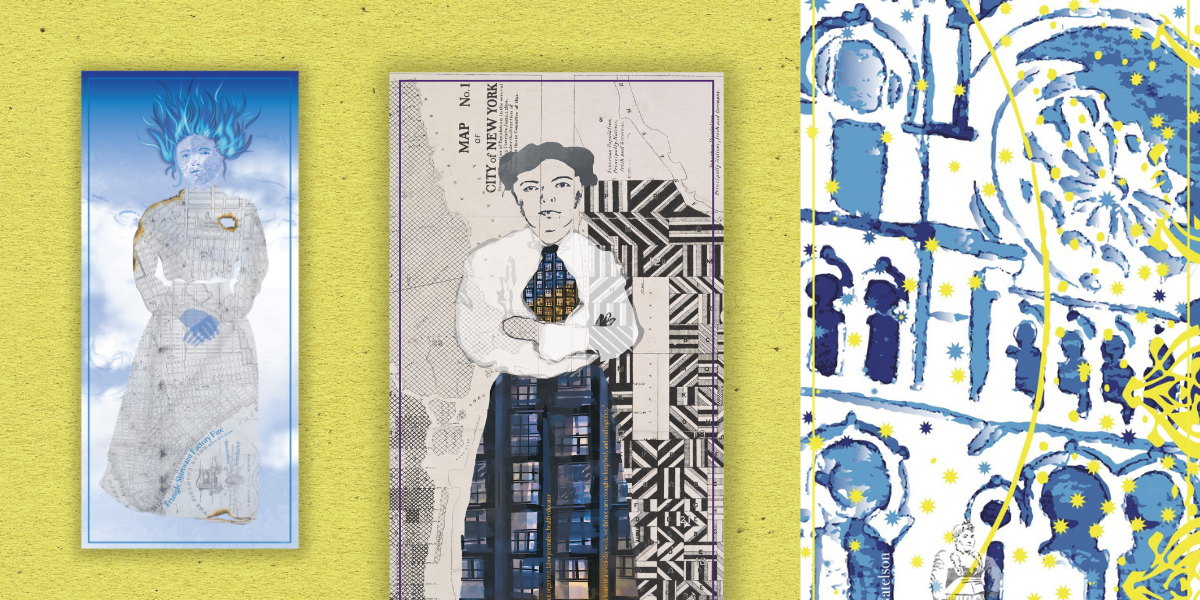Arts
Exhibit
Fabric of Their Lives

With arms folded across the front of a crisp white shirt, the portrait of Pauline Newman embodies determination. Her black skirt is populated with squares that, upon close inspection, reveal themselves to be tenement windows. The image, on a life-sized fabric banner at the Museum at Eldridge Street on Manhattan’s Lower East Side, is a fitting depiction of the labor rights activist. Before she became the first female general organizer of the International Ladies Garment Workers Union in 1909, she had led the largest rent strike in the city’s history.
Newman, who emigrated as a child from Lithuania, is one of 11 Jewish women portrayed in portraits on fabric by multimedia artist Adrienne Ottenberg in her first solo show, “28 Remarkable Women and One Scoundrel,” now at the museum housed in the iconic Eldridge Street Synagogue. The exhibition, which runs through May 5, also includes Christian and Black and Chinese women who lived and worked on the Lower East Side in the early 1900s. Printed on silk and cotton in muted shades of blue, violet, cream and brown, each work of art includes historic maps that connect the women to the Lower East Side or other parts of New York City.
The banners are placed throughout the first floor and gallery rooms, with several in the stairwell and in the women’s balcony of the synagogue. Each is accompanied by a small plaque with descriptions of the woman’s life.
While Ottenberg’s medium is ethereal—the banners flutter and float in their spaces—the stories she tells are not.
There is garment worker Dora Welfowitz, who lived at 11 Division Street and died alongside 146 other young women in the Triangle Shirtwaist Factory fire in 1911. The catastrophe, due largely to poor working conditions, led to changes in worker safety regulations. Her hair is shown fanning away from her face like a flame, and the map that makes up her dress is a copy of one used by the fire department of her era to navigate the streets of Manhattan.
Feminist and health care activist Fania Mindell’s portrait includes a map of Brooklyn. A co-founder with Margaret Sanger and Ethel Byrne of Brooklyn’s Brownsville Clinic, the first birth control clinic in the United States, Mindell disseminated information about birth control in Yiddish, Russian and Italian—actions that got her arrested.
Other notable Jewish figures featured include Yiddish theater actor Molly Picon, poet Emma Lazarus and activist Emma Goldman. And then there is the titular “scoundrel”—local Jewish petty criminal Stiff Rivka.
“Adrienne Ottenberg’s striking portraits inhabit the museum’s historic space with important stories to tell, some familiar, many forgotten,” said Nancy Johnson, the museum’s curator and archivist. “The exhibition connects us to the past in a meaningful way—to our Lower East Side neighborhood and to these women whose legacies continue to affect our lives today.”
Ottenberg’s inspiration for the show stems from a visit to the Eldridge Street Synagogue back in the 1990s. After visiting the women’s gallery, she began wondering about the women who once inhabited the area.
“There was this contrast between the beautiful Eldridge Street Synagogue and the craziness of the neighborhood,” said the artist, who lives in Manhattan. “It’s disruptive in a beautiful way, like the women.”
Cathryn J. Prince is the author of several nonfiction books, most recently Queen of the Mountaineers: The Trailblazing Life of Fanny Bullock Workman.










 Facebook
Facebook Instagram
Instagram Twitter
Twitter
Leave a Reply